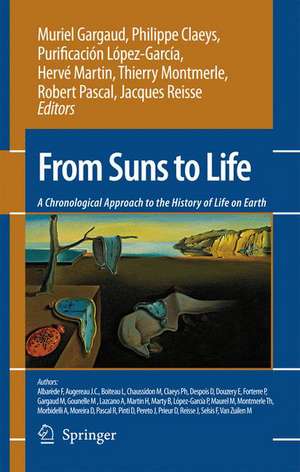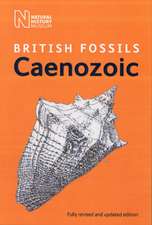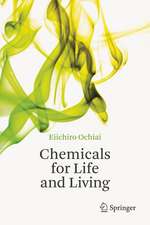From Suns to Life: A Chronological Approach to the History of Life on Earth
Editat de Muriel Gargaud, Philippe Claeys, Purificación López-García, Hervé Martin, Thierry Montmerle, Robert Pascal, Jacques Reisseen Limba Engleză Hardback – 28 dec 2006
The main chapters of this review present the formation and evolution of the solar system (3); the building of a habitable planet (4); prebiotic chemistry, biochemistry, and the emergence of life (5); the environmental context of the early Earth (6); and the ancient fossil record and early evolution (7). The concluding chapter (9) provides the highlights of the review and presents the different points of view about the universality of life. Two pedagogical chapters are included; one on chronometers (2), another in the form of a "frieze" (8) which summarizes in graphical form the present state of knowledge about the chronology of the emergence of life on Earth, before the Cambrian explosion.
| Toate formatele și edițiile | Preț | Express |
|---|---|---|
| Paperback (1) | 644.49 lei 43-57 zile | |
| Springer – 23 aug 2016 | 644.49 lei 43-57 zile | |
| Hardback (1) | 656.10 lei 43-57 zile | |
| Springer – 28 dec 2006 | 656.10 lei 43-57 zile |
Preț: 656.10 lei
Preț vechi: 771.89 lei
-15% Nou
Puncte Express: 984
Preț estimativ în valută:
125.55€ • 131.41$ • 104.49£
125.55€ • 131.41$ • 104.49£
Carte tipărită la comandă
Livrare economică 31 martie-14 aprilie
Preluare comenzi: 021 569.72.76
Specificații
ISBN-13: 9780387450827
ISBN-10: 0387450823
Pagini: 372
Ilustrații: VIII, 370 p.
Dimensiuni: 155 x 235 x 20 mm
Greutate: 0.85 kg
Ediția:2006
Editura: Springer
Colecția Springer
Locul publicării:New York, NY, United States
ISBN-10: 0387450823
Pagini: 372
Ilustrații: VIII, 370 p.
Dimensiuni: 155 x 235 x 20 mm
Greutate: 0.85 kg
Ediția:2006
Editura: Springer
Colecția Springer
Locul publicării:New York, NY, United States
Public țintă
Professional/practitionerCuprins
From the Arrow of Time to the Arrow of Life.- Dating Methods and Corresponding Chronometers in Astrobiology.- Solar System Formation and Early Evolution: the First 100 Million Years.- Building of a Habitable Planet.- Prebiotic Chemistry — Biochemistry — Emergence of Life (4.4-2 Ga).- Environmental Context.- Ancient Fossil Record and Early Evolution (ca. 3.8 to 0.5 Ga).- A Synthetic Interdisciplinary “Chronological Frieze”: an Attempt.- Life On Earth... And Elsewhere?.
Notă biografică
Jacques Reisse: Professor of organic chemistry and physical chemistry- Université Libre de Bruxelles
Member of the Royal Academy of Belgium
Research activity: stereochemistry, study of intermolecular interactions in liquid phase, nuclear magnetic resonance, cosmochemistry, sonochemistry
Antonio Lazcano, Professor at the Universidad Nacional Autónoma de México (UNAM) in Mexico City.
President of the International Society for the Study of the Origin of Life
Research activity: origin and early evolution of life
He is the author of The Origin of Life, which has become a bestseller with over 600 thousand copies sold.
He is considered the foremost promoter of evolutionary biology and the study of the origins of life in Latin America. He has been member of the editorial boards of the Journal of Molecular Evolution, Nanobiology, Revista Latinoamericana de Microbiologia, and Origins of Life and Evolution of the Biosphere.
Member of the Royal Academy of Belgium
Research activity: stereochemistry, study of intermolecular interactions in liquid phase, nuclear magnetic resonance, cosmochemistry, sonochemistry
Antonio Lazcano, Professor at the Universidad Nacional Autónoma de México (UNAM) in Mexico City.
President of the International Society for the Study of the Origin of Life
Research activity: origin and early evolution of life
He is the author of The Origin of Life, which has become a bestseller with over 600 thousand copies sold.
He is considered the foremost promoter of evolutionary biology and the study of the origins of life in Latin America. He has been member of the editorial boards of the Journal of Molecular Evolution, Nanobiology, Revista Latinoamericana de Microbiologia, and Origins of Life and Evolution of the Biosphere.
Textul de pe ultima copertă
This review emerged from several interdisciplinary meetings and schools gathering a group of astronomers, geologists, biologists, and chemists, attempting to share their specialized knowledge around a common question: how did life emerge on Earth? Their ultimate goal was to provide some kind of answer as a prerequisite to an even more demanding question: is life universal? The resulting state-of-the-art articles were written by twenty-five scientists telling a not-so linear story, but on the contrary, highlighting problems, gaps, and controversies. Needless to say, this approach yielded no definitive answers to both questions. However, by adopting a chronological approach to the question of the emergence of life on Earth, the only place where we know for sure that life exists; it was possible to break down this question into several sub-topics that can be addressed by the different disciplines.
The main chapters of this review present the formation and evolution of the solar system (3); the building of a habitable planet (4); prebiotic chemistry, biochemistry, and the emergence of life (5); the environmental context of the early Earth (6); and the ancient fossil record and early evolution (7). The concluding chapter (9) provides the highlights of the review and presents the different points of view about the universality of life. Two pedagogical chapters are included; one on chronometers (2), another in the form of a "frieze" (8) which summarizes in graphical form the present state of knowledge about the chronology of the emergence of life on Earth, before the Cambrian explosion.
The main chapters of this review present the formation and evolution of the solar system (3); the building of a habitable planet (4); prebiotic chemistry, biochemistry, and the emergence of life (5); the environmental context of the early Earth (6); and the ancient fossil record and early evolution (7). The concluding chapter (9) provides the highlights of the review and presents the different points of view about the universality of life. Two pedagogical chapters are included; one on chronometers (2), another in the form of a "frieze" (8) which summarizes in graphical form the present state of knowledge about the chronology of the emergence of life on Earth, before the Cambrian explosion.
Caracteristici
Presents a complete review of the history of life stretching 2.5 billion years Uniquely multidisciplinary touching astronomy, geology, chemistry, biochemistry and biology Comes with a colorful interdisciplinary fold-out graph showing the main events that have led to the emergence of life










